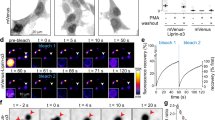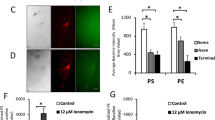Abstract
To survive, neurons and other eukaryotic cells must rapidly repair (seal) plasmalemmal damage. Such repair occurs by an accumulation of intracellular vesicles at or near the plasmalemmal disruption. Diacylglycerol (DAG)-dependent and cAMP-dependent proteins are involved in many vesicle trafficking pathways. Although recent studies have implicated the signaling molecule cAMP in sealing, no study has investigated how DAG and DAG-dependent proteins affect sealing. By means of dye exclusion to assess Ca2+-dependent vesicle-mediated sealing of transected neurites of individually identifiable rat hippocampal B104 cells, we now report that, compared to non-treated controls, sealing probabilities and rates are increased by DAG and cAMP analogs that activate PKC and Munc13-1 and PKA. Sealing is decreased by inhibiting DAG-activated novel protein kinase C isozymes η (nPKCη) and θ (nPKCθ) and Munc13-1, the PKC effector myristoylated alanine rich PKC substrate (MARCKS) or phospholipase C (PLC). DAG-increased sealing is prevented by inhibiting MARCKS or protein kinase A (PKA). Sealing probability is further decreased by simultaneously inhibiting nPKCη, nPKCθ, and PKA. Extracellular Ca2+, DAG, or cAMP analogs do not affect this decrease in sealing. These and other data suggest that DAG increases sealing through MARCKS and that nPKCη, nPKCθ, and PKA are all required to seal plasmalemmal damage in B104 and likely all eukaryotic cells.







Similar content being viewed by others
References
Agresti A (1996) An introduction to categorical data analysis. John Wiley and Sons, New York, p 285
Agrawal A, Rengarajan S, Adler KB, Ram A, Ghosh B, Fahim M, Dickey BF (2007) Inhibition of mucin secretion with MARCKS-related peptide improves airway obstruction in a mouse model of asthma. J Appl Physiol 102(1):399–405
Ballinger ML, Blanchette AR, Krause TL, Smyers ME, Fishman HM, Bittner GD (1997) Delaminating myelin membranes help seal the cut ends of severed earthworm giant axons. J Neurobiol 33(7):945–960
Barros SA, Srimaroeng C, Perry JL, Walden R, Dembla-Rajpal N, Sweet DH, Pritchard JB (2009) Activation of protein kinase Cζ increases OAT1 (SLC22A6)- and OAT3 (SLC22A8)-mediated transport. J Biol Chem 284(5):2672–2679
Basu J, Betz A, Brose N, Rosenmund C (2007) Munc13-1 C1 domain activation lowers the energy barrier for synaptic vesicle fusion. J Neurosci 27(5):1200–1210
Bittner GD, Keating CP, Kane JR, Britt JM, Spaeth CS, Fan JD, Zuzek A, Wilcott RW, Thayer WP, Winograd JM, Gonzalez-Lima F, Schallert T (2012) Rapid, effective and long-lasting behavioral recovery produced by microsutures, methylene blue, and polyethylene glycol after completely cutting rat sciatic nerves. J Neurosci Res. doi:10.1002/jnr.23023
Blanchette AR, Ballinger ML, Fishman HM, Bittner GD (1999) Calcium entry initiates processes that restore a barrier to dye entry in severed earthworm giant axons. Neurosci Lett 272(3):147–150
Bleasdale JE, Thakur NR, Gremban RS, Bundy GL, Fitzpatrick FA, Smith RJ, Bunting S (1990) Selective inhibition of receptor-coupled phospholipase C-dependent processes in human platelets and polymorphonuclear neutrophils. J Pharmacol Exp Ther 255(2):756–768
Bottenstein JE, Sato GH (1979) Growth of a rat neuroblastoma cell line in serum-free supplemental medium. Proc Natl Acad Sci USA 76(1):514–517
Bozkurt A, Brook GA, Moellers S, Lassner F, Sellhaus B, Weis J, Woeltje M, Tank J, Beckmann C, Fuchs P, Damink LO, Schügner F, Heschel I, Pallua N (2007) In vitro assessment of axonal growth using dorsal root ganglia explants in a novel three-dimensional collagen matrix. Tissue eng 12:2971–2979
Brose N, Rosenmund C (2002) Move over protein kinase C, you’ve got company: alternative cellular effectors of diacylglycerol and phorbol esters. J Cell Sci 115:4399–4411
Churchill EN, Qvit N, Mochly-Rosen D (2009) Rationally designed peptide regulators of protein kinase C. Trends Endocrinol Metab 20(1):25–33
Damera G, Jester WF, Jiang M, Zhao H, Fogle HW, Mittelman M, Haczku A, Murphy E, Parikh I, Panettieri RA Jr (2010) Inhibition of Myristoylated Alanine-rich C kinase substrate (MARCKS) protein inhibits ozone-induced airway neutrophilia and inflammation. Exp Lung Res 36(2):75–84
Davies SP, Reddy H, Caivano M, Cohen P (2000) Specificity and mechanism of action of some commonly used protein kinase inhibitors. Biochem J 351:95–105
Detrait E, Eddleman CS, Yoo S, Fukuda M, Nguyen MP, Bittner GD, Fishman HM (2000a) Axolemmal repair requires proteins that mediate synaptic vesicle fusion. J Neurobiol 44:382–391
Detrait ER, Yoo S, Eddleman CS, Fukuda M, Bittner GD, Fishman HM (2000b) Plasmalemmal repair of severed neurites of PC12 cells requires Ca2+ and Synaptotagmin. J Neurosci Res 62:566–573
Doherty CM, Tarchala SM, Radwanska E, De Jonge CJ (1995) Characterization of two second messenger pathways and their interactions in eliciting the human sperm acrosome reaction. J Androl 16(1):36–46
Eddleman CS, Ballinger ML, Smyers ME, Godell CM, Fishman HM, Bittner GD (1997) Repair of plasmalemmal lesions by vesicles. Proc Natl Acad Sci USA 94(9):4745–4750
Eddleman CS, Ballinger ML, Smyers ME, Fishman HM, Bittner GD (1998) Endocytotic formation of vesicles and other membranous structures induced by Ca2+ and axolemmal injury. J Neurosci 18(11):4029–4041
Eddleman CS, Bittner GD, Fishman HM (2000) Barrier permeability at cut axonal ends progressively decreases until an ionic seal is formed. Biophy J 79(4):1883–1890
Fishman HM, Bittner GD (2003) Vesicle-mediated restoration of a plasmalemmal barrier in severed axons. News Physiol Sci 18:115–118
Frey D, Laux T, Xu L, Schneider C, Caroni P (2000) Shared and unique roles of CAP23 and GAP43 in actin regulation, neurite outgrowth and anatomical plasticity. J Cell Biol 149(7):1443–1453
Gatlin JC, Estrada-Bernal A, Sanford SD, Pfenninger KH (2006) Myristoylated, Alanine-rich C-kinase substrate phosphorylation regulates growth cone adhesion and pathfinding. Mol Biol Cell 17(12):5115–5130
Glass JD, Culver DG, Levey AI, Nash NR (2002) Very early activation of m-calpain in peripheral nerve during Wallerian degeneration. J Neurol Sci 196:9–20
Godell CM, Smyers ME, Eddleman CS, Ballinger ML, Fishman HM, Bittner GD (1997) Calpain activity promotes the sealing of severed giant axons. Proc Natl Acad Sci Neurobiol 94:4751–4756
Hildebrandt JP, Plant TD, Meves H (1997) The effects of bradykinin on K+ currents in NG108-15 cells treated with U73122, a phospholipase C inhibitor, or neomycin. Br J Pharmacol 120:841–850
Ju M, Shi J, Saleh SN, Albert AP, Large WA (2010) Ins(1,4,5)P3 interacts with PIP2 to regulate activation of TRPC6/C7 channels by diacylglycerol in native vascular myocytes. J Physiol 588(Pt 9):1419–1433
Jungnickel MK, Sutton KA, Wang Y, Florman HM (2007) Phosphoinositide-dependent pathways in mouse sperm are regulated by egg ZP3 and drive the acrosome reaction. Dev Biol 304:116–126
Kolkova K, Novitskaya V, Pedersen N, Berezin V, Bock E (2000) Neural cell adhesion molecule-stimulated neurite outgrowth depends on activation of protein kinase C and the ras-mitogen-activated protein kinase pathway. J Neurosci 20(6):2238–2246
Krause TL, Fishman HM, Ballinger ML, Bittner GD (1994) Extent and mechanism of sealing in transected giant axons of squid and earthworms. J Neurosci 14(11):6638–6651
Larsson C (2006) Protein Kinase C and the regulation of the actin cytoskeleton. Cell Signal 18:276–284
Laux T, Fukami K, Thelen M, Golub T, Frey D, Caroni P (2000) GAP43, MARCKS and CAP23 modulate PI(4,5)P2 at plasmalemmal rafts, and regulate cell cortex actin dynamics through a common mechanism. J Cell Biol 149(7):1455–1471
Liu XF, Xie X, Miki T (2006) Inhibition of protein kinase C ζ blocks the attachment of stable microtubules to kinteochores leading to abnormal chromosome alignment. Cell Signal 18:2314–2323
McNeil PL, Terasaki M (2001) Coping with the inevitable: how cells repair a torn surface membrane. Nat Cell Biol 3:124–129
Miller MW, Mooney SM, Middleton FA (2006) Transforming growth factor beta1 and ethanol affect transportation and translation of genes and proteins for cell adhesion molecules in B104 neuroblastoma cells. J Neurochem 97(4):1182–1190
Mochida S, Orita S, Sakaguchi G, Sasaki T, Takai Y (1998) Role of the Doc2α-Munc13-1 interaction in the neurotransmitter release process. Proc Natl Acad Sci USA 95(19):11418–11422
Nguyen MP, Bittner GD, Fishman HM (2005) Critical interval of somal calcium transient after neurite transection determines B104 cell survival. J Neurosci Res 81:805–816
Ratz PH, Miner AS (2009) Role of protein kinase Cζ and calcium entry in KCl-induced vascular smooth muscle calcium sensitization and feedback control of cellular calcium levels. J Pharmacol Exp Ther 328(2):399–408
Reddy A, Caler EV, Andrews NW (2001) Plasma membrane repair is mediated by Ca(2+)-regulated exocytosis of lysosomes. Cell 106(2):157–169
Rodriguez L, Stirling CJ, Woodman PG (1994) Multiple N-ethylmaleimide-sensitive components are required for endosomal vesicle fusion. Mol Biol Cell 5:773–783
Rodriguez-Sinovas A, Garcia-Dorado D, Pina P, Ruiz-Meana M, Soler-Soler J (2005) Effect of sarcolemmal rupture on myocardial electrical impedance during oxygen deprivation. Am J Physiol Heart Circ Physiol 288:H1396–1403
Schlaepfer WW, Bunge RP (1973) Effects of calcium ion concentration on the degeneration of amputated axons in tissue culture. J Cell Biol 59:456–470
Shen SS, Steinhardt RA (2005) The mechanisms of cell membrane resealing in rabbit corneal epithelial cells. Curr Eye Res 30:543–554
Siskova Z, Baron W, de Vries H, Hoekstra D (2006) Fibronectin impedes “myelin” sheet-directed flow in oligodendrocytes: a role for a beta 1 integrin-mediated PKC signaling pathway in vesicluar trafficking. Mol Cell Neurosci 33:150–159
Sivasankaran R, Pei J, Wang KC, Zhang YP, Shields CB, Xu XM, He Z (2004) PKC mediates inhibitory effects of myelin and chondroitin sulfate proteoglycans on axonal regeneration. Nat Neurosci 7(3):261–268
Spaeth CS, Boydston EA, Figard LR, Zuzek A, Bittner GD (2010) A model for sealing plasmalemmal damage in neurons and other eukaryotic cells. J Neurosci 30(47):15790–15800
Spaeth CS, Spaeth EA, Wilcott R, Fan JD, Robison T, Bittner GD (2011) Pathways for plasmalemmal repair mediated by PKA, Epac and cytosolic oxidation in rat B104 cells in vitro and rat sciatic axons ex vivo. Dev Neurobiol. doi:10.1002/dneu.20998
Staal RGW, Hananiya A, Sulzer D (2008) PKCθ activity maintains normal quantal size in chromaffin cells. J Neurochem 105:1635–1641
Steinberg SF (2008) Structural basis of protein kinase C isoforms function. Physiol Rev 88(4):1341–1378
Steinhardt RA, Bi G, Alderton JM (1994) Cell membrane resealing by a vesicular mechanism similar to neurotransmitter release. Science 263:390–393
Tanaka Y, Okamoto T, Imai T, Horinouchi T, Tanaka H, Shigenobu K, Koike K (2003) Phospholipase C inhibitors suppress spontaneous mechanical activity of guinea pig urinary bladder smooth muscle. Biol Pharm Bull 26(8):1192–1194
Togo T (2004) Long-term potentiation of wound-induced exocytosis and plasma membrane repair is dependent on cAMP-response element-mediated transcription via a protein kinase C and p38 MAPK-dependent pathway. J Biol Chem 279(43):44996–45003
Togo T, Alderton JM, Steinhardt RA (2003) Long-term potentiation of exocytosis and cell membrane repair in fibroblasts. Mol Biol Cell 14:93–106
Tsai SY, Yang LY, Wu CH, Chang SF, Hsu CY, Wei CP, Leu SJ, Liaw J, Lee HY, Tsai MD (2007) Injury-induced janus kinase/protein kinase c-dependent phosphorylation of growth-associated protein 43 and signal transducer and activator of transcription 3 for neurite growth in dorsal root ganglion. J Neurosci Res 85:321–327
Wang Y, Oram JF (2007) Unsaturated fatty acids phosphorylated and destabilize ABCA1 through a protein kinase C delta pathway. J Lipid Res 48(5):1062–1068
Yoo S, Nguyen MP, Fukuda M, Bittner GD, Fishman HM (2003) Plasmalemmal sealing of transected mammalian neurites is a gradual process mediated by Ca2+ -regulated proteins. J Neurosci Res 74:541–551
Yoo S, Bottenstein JE, Bittner GD, Fishman HM (2004) Survival of mammalian B104 cells following neurite transection at different locations depends on somal Ca2+ concentration. J Neurobiol 60(2):137–153
Acknowledgments
The research was supported by grants from the Lone Star Paralysis Foundation (www.lonestarparalysis.org). The authors would like to thank Dr. Van A. Herd and Robert “Rip” Wilcott for their input and commentary, and Deborah Surman for her maintenance of B104 cell cultures.
Author information
Authors and Affiliations
Corresponding author
Electronic supplementary material
Below is the link to the electronic supplementary material.
Rights and permissions
About this article
Cite this article
Zuzek, A., Fan, J.D., Spaeth, C.S. et al. Sealing of Transected Neurites of Rat B104 Cells Requires a Diacylglycerol PKC-Dependent Pathway and a PKA-Dependent Pathway. Cell Mol Neurobiol 33, 31–46 (2013). https://doi.org/10.1007/s10571-012-9868-5
Received:
Accepted:
Published:
Issue Date:
DOI: https://doi.org/10.1007/s10571-012-9868-5




